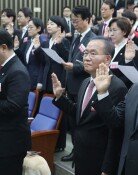Domestic private universities need to implement structural reforms
Domestic private universities need to implement structural reforms
Posted March. 03, 2014 07:03,
Korean private universities run 61 departments each, fail to select and focus
Here are two universities. One has 18 colleges (100 departments) and 23,000 students enrolled, while the other has five colleges (39 departments) and 6,700 undergraduate students (as of last year). The former is a private university in a provincial region in Korea, and the other is Harvard University in the U.S. The private university in Korea prepared a restructuring plan and started efforts to merge departments half a year ago in preparation for the Education Ministrys plan to reduce student quotas, but has hardly executed the plan in the face of opposition by school insiders including professors.
The Dong-A Ilbo analyzed composition of departments and academic affairs process at domestic universities jointly with a team led by Prof. Bae Yeong-chan at Hanyang university, to find that domestic private universities are excessively large in size compared with prestigious universities overseas. The average number of departments in Korean private universities is 61.3, a figure that is larger by more than 10 compared with those in the U.S. (48.1), and the U.K. (46). In contrast, the number of departments (77.5) at national and public universities in Korea was smaller than that (80.5) of state universities in the U.S., which are national or public universities. The situation is effectively the opposite of the education authoritys plan to nurture national and public universities into hub universities for respective regions and develop them into large general universities, while developing private universities into small but strong specialty universities.
Another problem that has been revealed is composition of departments. The ratio of private Korean universities that have departments related to architecture, journalism, and pedagogy, was over 30 percentage points higher when compared with that of private universities overseas. The ratio of Korean private universities with English-related departments came to 94.7 percent, which is higher than that (81.8 percent) at private universities in the U.S. and the U.K. where English is mother tongue. On the other hand, the ratio of universities that have departments related to philosophy, physics, life science, and chemistry, which are basic studies, was lower than that at private universities overseas. The finding suggests that while foreign universities seek to develop basic studies departments, and select and focus other departments by considering demand, Korean universities operate too many different departments as if they are a department store.
Bae said, This situation should no longer be left intact. It is time that universities should kill two birds, namely reduction of student quotas and restructuring of departments, with one stone by strongly implementing merger and integration of departments and other measures.







